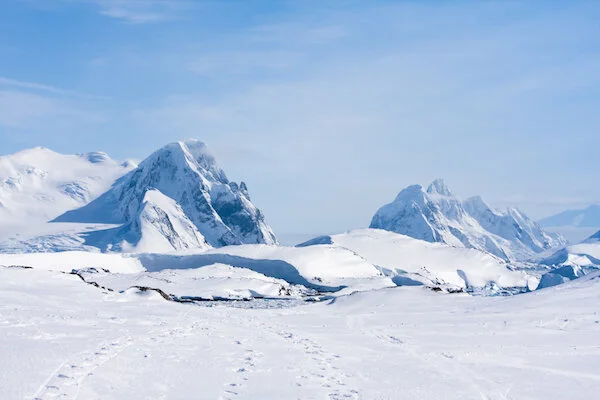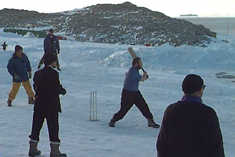Antarctica is at the bottom of the Earth.
The South Pole is there.
It is the coldest place on Earth.
It is the windiest place on Earth.
It is a desert that is the driest place on Earth.
You can see penguins and seals there.
Antarctica is the continent on which the South Pole is located.
The southernmost continent on the Earth. ©Getty Images
However, it was joined on to Australia about 500 million years ago! The continent separated from Australia and drifted south, down to the bottom of the earth.
Antarctica is permanently frozen. It is often called 'the frozen continent'. About 90% of the world's ice is in Antarctica. Most of the world's fresh water is frozen around the South Pole. Almost all of the land of Antarctica is covered in ice sheet. Only about 2% of the land shows through the ice.
In winter, the sea freezes and the size of Antarctica almost doubles. The average thickness of the ice sheet is about 2,200 metres. At its thickest point the ice is about 4,776 metres, which is similar to the height of the Alps! It is estimated that the weight of all this ice is so great that if it were removed, Antarctica would rise about 1,000 metres. Because of the thickness of the ice, Antarctica is the highest continent.
In all the world, Antarctica is the:
coldest place: the coldest temperature ever recorded was at the South Pole... minus 88ºC (88º below 0º);
windiest place: winds can reach over 300 km an hour, the most severe winds being the katabatic winds;
driest place: about 4cm of rain (less than in the Sahara Desert) falls each year, in the form of snow.
Summer in Antarctica ©Getty Images
Antarctica is the world's largest desert
Antarctica is the world's largest desert because it has so little rain and very little grows there. No rain has fallen in the part of Antarctica called the Dry Valleys for over 2 million years. There are just two seasons in Antarctica: a very short cold summer and a very long, colder winter. At the South Pole, there is just one period of daylight each year, and it lasts for six months! The other six months of the year are dark - the sun does not come above the horizon. This is because the Earth is tilted and curved, so the sun doesn't shine as strongly onto the poles as it does at the Equator.
Sunrise over the mountains. ©Getty Images
Of the sunlight that does reach Antarctica, about 90%-95% of it bounces off again because ice is an excellent reflector of sunlight. This means that only about 5%-10% of the solar energy is available for warming. As a comparison: grasslands reflect 30%-40% and a conifer forest 10%-15%.
Antarctica is the highest continent.
The South Pole is at a high altitude of 2 835 metres (Australia's Mt Kosciusko is 2 228m), located on what is called the Antarctic Plateau. Some parts of the Antarctic Plateau are higher than 4, 215 m. Antarctica's Highest Point, the Vinson Massif, 4 897 metres high, is the tallest mountain in Antarctica. It is part of the Ellsworth Mountains. Mt Erebus, 3 794 metres located on Ross Island in the Ross Sea, is an active volcano with a lava lake within its crater. It has been continuously active since 1972. Most of its eruptions are small.
Supplies for a base arrive in summer and must last for a year because ships can't get there in winter. ©Getty Images
The longest glacier in the world is in East Antarctica.
It is the Lambert -Fisher Ice Passage which runs through the Prince Charles Mountains. It is 515 kilometres long and 40 kilometres wide. It moves at speeds of up to nearly 1005 metres per year and is up to 2 499 metres deep.
No one lives in Antarctica permanently.
Scientists stay for periods of time doing research. Antarctica is therefore not a country like other places. Twelve countries signed the Antarctic Treaty and have territories in Antarctica on which they have built bases. Scientific teams from those countries stay in their country's base when they visit Antarctica. Australia is one of the countries that signed the Treaty, and has the largest Antarctic territory.
Why is Antarctica important?
The Antarctic ice sheet is over 70% of Earth's fresh water and about 90% of Earth's ice. If it melted, the world's sea level would rise about 70 metres. Cold water, full of oxygen, originates in Antarctica and flows out into the other oceans, helping circulate and refresh ocean waters. The sea surrounding Antarctica is home to marine life from tiny algae to huge whales. Scientists are trying to find out how Antarctica responds to environmental change, which will help them better predict how the rest of Earth will respond to future environmental changes.
A research station, with ropes connecting it to the base to ensure safety of travel.©Getty Images
Visitors to Antarctica
People who go to Antarctica must learn many survival skills. Special housing is necessary because of the extreme cold and incredible winds that can blast the continent. Special clothing and equipment is necessary, and all members of the team must learn some medical skills in case of emergencies. In 1961, a Russian doctor on an Antarctic expedition conducted a successful appendicitis operation... on himself. They must learn how to deal with different conditions that may arise, such as 'whiteout' which can occur at any time, when people can hardly see their hand in front of their face. People can easily become lost even if they are close to shelter. For this reason, there are often ropes they hold if moving between buildings. When they are travelling there are other hazards such as snow completely hiding holes that may be over a hundred metres deep. In summer, tourists can now make brief visits to see Antarctica.
Passenger ships sail all around the continent and anchor off the coast. Smaller boats take people from their ship to land, where they can enjoy guided walks. Some huts of the early explorers have been preserved and can be visited. Planes sometimes fly over Antarctica so people can see it from the air.
Dog sleds are no longer used in the Antarctic, to protect the seals from catching any diseases such as distemper. The Antarctic bases have a variety of motor vehicles.
Antarctica and the Arctic: What's the difference?
Antarctica is a continent surrounding the South Pole. Penguins live there, but not polar bears.
The Arctic is an ocean surrounding the North Pole. Polar bears live there, but not penguins.
There are lines marked on a map or globe going around the Earth, with the Equator in the middle. The most northern one that circles the area where the North Pole is located, is the Arctic Circle. The most southern one that circles the area where the South Pole is located, is the Antarctic Circle.
Read the kidcyber page: The North and South Poles.
Who owns Antarctica?
This is the ceremonial South Pole, ringed by the flag of each country that signed the Antarctic Treaty. ©Getty Images
No one country owns Antarctica, but thirty nine nations each have territories, or sections of Antarctica . The Antarctic Treaty was signed by twelve nations on 1st December 1959, and came into effect on June 23rd, 1961. Since then, 28 other nations have become signatories.
The Treaty is an excellent and unique example of international cooperation. It bans any military activity or nuclear testing in Antarctica, and allows nations to conduct scientific research only. The Treaty includes all the land and iceshelves south of 60° S. The Treaty also ensures free exchange of information and scientists between countries, and gives nations the right to inspect the Antarctic operations of other countries.
Territories and bases of Antarctica. ©Getty Images
Of the thirty-nine countries that have become signatories to the Antarctic Treaty, there are 25 which are engaged in large scale scientific research.
Research station supply ships can only bring in supplies in summer, so a full year's supplies come all at once. This generally means maintaining a year-round station on the continent. Among these are the twelve original signatories: Argentina, Australia, Belgium, Chile, France, Japan, New Zealand, Norway, South Africa, the Soviet Union (now Russia), the United Kingdom and the United States. Of these, Australia has the largest Antarctic territory.
In summer, Australians play cricket... even in Antarctica! This is Casey Base. ©Getty Images









